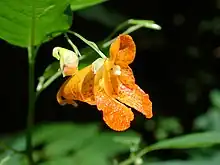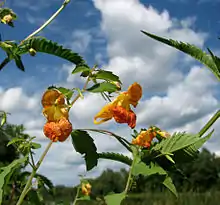Impatiens capensis
Impatiens capensis, the orange jewelweed, common jewelweed, spotted jewelweed, jewelweed,[3] spotted touch-me-not, or orange balsam,[4] is an annual plant in the family Balsaminaceae that is native to North America.[5] It is common in bottomland soils, ditches, and along creeks, often growing side by side with its less common relative, yellow jewelweed (I. pallida).
| Orange jewelweed | |
|---|---|
 | |
| Scientific classification | |
| Kingdom: | Plantae |
| Clade: | Tracheophytes |
| Clade: | Angiosperms |
| Clade: | Eudicots |
| Clade: | Asterids |
| Order: | Ericales |
| Family: | Balsaminaceae |
| Genus: | Impatiens |
| Species: | I. capensis |
| Binomial name | |
| Impatiens capensis | |
| Synonyms | |
|
Impatiens biflora Walter | |
Description

Jewelweed is an herbaceous plant that grows 0.9–1.5 m (3–5 ft) tall and blooms from late spring to early fall. The flowers are orange (sometimes blood orange or rarely yellow) with a three-lobed corolla; one of the calyx lobes is colored similarly to the corolla and forms a hooked conical spur at the back of the flower. Plants may also produce non-showy cleistogamous flowers, which do not require cross-pollination.[6]
It often branches extensively. The round stems are glabrous (smooth) and succulent,[7] and semi-translucent, with swollen or darkened nodes on some plants. The leaves, which measure up to 13 cm (5 in) long and 6 cm (2.5 in) across, are alternate on the upper stems and opposite on the lower stems (when present). The leaves are ovate to elliptic, simple, and have shallow, rounded teeth on the margins.[8] The seed pods have five valves which coil back rapidly to eject the seeds in a process called explosive dehiscence[9] or ballistochory. This reaction is where the name 'touch-me-not' comes from; in mature seed pods, dehiscence can easily be triggered with a light touch.
Distribution
Impatiens capensis was transported in the 19th and 20th centuries to England, France, the Netherlands, Poland, Sweden, Finland, and potentially other areas of northern and central Europe. These naturalized populations persist in the absence of any common cultivation by people. This jewelweed species is quite similar to Impatiens noli-tangere, an Impatiens species native to Europe and Asia, as well as the other North American Impatiens. No evidence exists of natural hybrids, although the habitats occupied by the two species are very similar.
In the State of Washington, Impatiens capensis is considered a class C noxious weed due to its rapid spread and tendency to outcompete native jewelweeds.[10] It has also formed a hybrid species with the native jewelweed Impatiens ecornuta.[11]
Uses
As food
The young shoots can be boiled (with two changes of water) as a potherb; eating too much is not recommended as the plant contains calcium oxalate crystals.[12] The seeds are also edible.[12]
Medicinal
Along with other species of jewelweed, the juice of the leaves and stems is a traditional Native American remedy for skin rashes, including poison ivy.[13][14] The effectiveness of its use to prevent the development of a rash after short-term exposure to poison ivy has been supported by peer-reviewed study, and is likely due to the plant containing saponins.[15][16] These studies also found that some individuals have a sensitivity to jewelweed which can cause a more severe rash.
The stem juice has also been used to treat athlete's foot; its fungicidal qualities have been scientifically verified.[17]
Etymology
The leaves appear to be silver or 'jeweled' when held underwater, which is possibly where the jewelweed name comes from. Another possible source of the name is the color and shape of the bright robin's egg-blue kernels of the green projectile seeds. Both the genus name Impatiens ("impatience" in Latin) and common name spotted touch-me-not refer to how its seeds when ripe pop open on touch. [18]
The species name capensis, meaning "of the cape", is actually a misnomer, as Nicolaas Meerburgh was under the mistaken impression that it was native to the Cape of Good Hope, in southern Africa.[19]
Pollination

Nectar spurs are tubular elongations of petals and sepals of certain flowers that usually contain nectar. Flowers of Impatiens capensis have these nectar spurs. Nectar spurs are thought to have played a role in plant-pollinator coevolution. Curvature angles of nectar spurs of Impatiens capensis are variable. This angle varies from 0 degrees to 270 degrees.[20]
The angle of the nectar spur is very important in the pollination of the flower and in determining the most efficient pollinator. Hummingbirds are major pollinators. They remove more pollen per visit from flowers with curved nectar spurs than with perpendicular nectar spurs.[20] But hummingbirds are not the only pollinators of Impatiens capensis. Bees, especially bumblebees play an important role in pollination as well. Due to hummingbirds and bees, the pollination of Impatiens capensis is very high.[21]
Gallery
 Leaves and flowers
Leaves and flowers Jewelweed growing on a creek side
Jewelweed growing on a creek side Flower
Flower_along_a_walking_path_in_the_Franklin_Farm_section_of_Oak_Hill%252C_Fairfax_County%252C_Virginia.jpg.webp) Leaf showing beads (jewels) just after rain
Leaf showing beads (jewels) just after rain
References
- Maiz-Tome, L. (2016). "Impatiens capensis". IUCN Red List of Threatened Species. 2016: e.T64314821A67729731. doi:10.2305/IUCN.UK.2016-1.RLTS.T64314821A67729731.en. Retrieved 10 September 2023.
- NatureServe (1 September 2023). "Impatiens capensis". NatureServe Network Biodiversity Location Data accessed through NatureServe Explorer. Arlington, Virginia: NatureServe. Retrieved 10 September 2023.
- Dickinson, T.; Metsger, D.; Bull, J.; Dickinson, R. (2004). ROM Field Guide to Wildflowers of Ontario. Toronto: Royal Ontario Museum and McClelland and Stewart Ltd. p. 197.
- BSBI List 2007 (xls). Botanical Society of Britain and Ireland. Archived from the original (xls) on 2015-06-26. Retrieved 2014-10-17.
- Ceska, Dr. A. (21 April 2009). "Botanical Electronic News, No. 408". Retrieved 15 June 2020.
- Hilty, John (2020). "Orange Jewelweed (Impatiens capensis)". Illinois Wildflowers.
- "Orange Jewelweed (Impatiens capensis)". www.illinoiswildflowers.info.
- "Know Your Natives – Spotted Jewelweed". Arkansas Native Plant Society. 31 July 2015.
- Hayashi, Marika; Feilich, Kara; Ellerby, David (May 2009). "The mechanics of explosive seed dispersal in orange jewelweed (Impatiens capensis)". Journal of Experimental Botany. 60 (7): 2045–2046. doi:10.1093/jxb/erp070. PMC 2682495. PMID 19321647.
- "Spotted Jewelweed". Washington State Noxious Weed Control Board. Washington State. Retrieved October 25, 2020.
- Zika, Peter (Sep 2006). "Impatiens ×pacifica (Balsaminaceae), a New Hybrid Jewelweed from the Pacific Northwest Coast of North America". Novon: A Journal for Botanical Nomenclature. 16 (3): 443–448. doi:10.3417/1055-3177(2006)16[443:IPBANH]2.0.CO;2. S2CID 83544635.
- Elias, Thomas S.; Dykeman, Peter A. (2009) [1982]. Edible Wild Plants: A North American Field Guide to Over 200 Natural Foods. New York: Sterling. p. 119. ISBN 978-1-4027-6715-9. OCLC 244766414.
- Smith, Huron H. (1933). "Ethnobotany of the Forest Potawatomi Indians". Bulletin of the Public Museum of the City of Milwaukee. 7: 42.
- Fagan, Damian (2019). Wildflowers of Oregon: A Field Guide to Over 400 Wildflowers, Trees, and Shrubs of the Coast, Cascades, and High Desert. Guilford, CT: FalconGuides. p. 227. ISBN 978-1-4930-3633-2. OCLC 1073035766.
- Motz, Vicki; Bowers, Christopher; Kneubehl, Alexander; Lendrum, Elizabeth; Young, Linda; Kinder, David (2015). "Efficacy of the saponin component of Impatiens capensis Meerb. in preventing urushiol-induced contact dermatitis". Journal of Ethnopharmacology. 162: 163–7. doi:10.1016/j.jep.2014.12.024. PMID 25543019.
- Motz; Bowers; Young; Kinder (2012). "The effectiveness of jewelweed, Impatiens capensis, the related cultivar I. balsamina and the component, lawsone in preventing post poison ivy exposure contact dermatitis". Journal of Ethnopharmacology. 143 (1): 314–318. doi:10.1016/j.jep.2012.06.038. PMID 22766473.
- Niering, William A.; Olmstead, Nancy C. (1985) [1979]. The Audubon Society Field Guide to North American Wildflowers, Eastern Region. Knopf. p. 414. ISBN 0-394-50432-1.
- "Wildflowers of the Adirondacks: Spotted Touch-Me-Not (Impatiens capensis)". ADIRONDACKS FOREVER WILD. Wild Adirondacks. Retrieved 28 August 2022.
- Strausbaugh, P.D.; Core, E. L. (1964). Flora of West Virginia (2nd ed.). Seneca Books. p. 622. ISBN 978-0-89092-010-7.
- Travers, Steven E; Temeles, Ethan J; Pan, Irvin (2003). "The relationship between nectar spur curvature in jewelweed (Impatiens capensis) and pollen removal by hummingbird pollinators". Canadian Journal of Botany. 81 (2): 164–70. doi:10.1139/b03-014.
- Elemans, Marjet (2004). "Light, nutrients and the growth of herbaceous forest species". Acta Oecologica. 26 (3): 197–202. Bibcode:2004AcO....26..197E. doi:10.1016/j.actao.2004.05.003.

